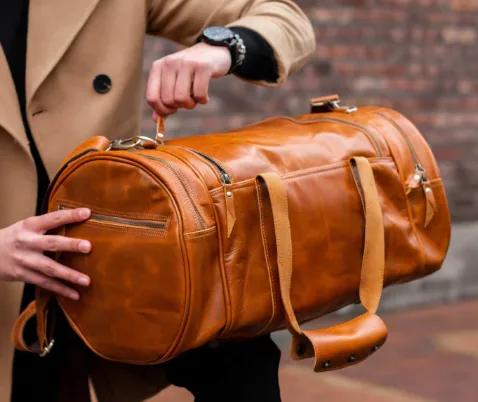Buffalo leather stands out as one of the rare and exceptionally durable leathers in the market, valued for its unmatched toughness and long lifespan. It has become a preferred choice among every buffalo leather bag maker who needs a material that balances strength and beauty for long-lasting products. Beyond its durability, buffalo leather carries an emotional appeal—it embodies a sense of rugged luxury, combining raw power with timeless elegance. Its distinctive deep grain pattern gives each piece a unique identity, ensuring no two custom buffalo leather bags ever look the same. Functionally, buffalo leather is highly resistant to scratches and naturally water-repellent, making it a reliable option for brands working with a professional buffalo leather manufacturer.
In this article, we’ll explore the story behind buffalo leather—its origins, production, and why it continues to hold a strong position in the leather industry.
Contents
What is buffalo leather?
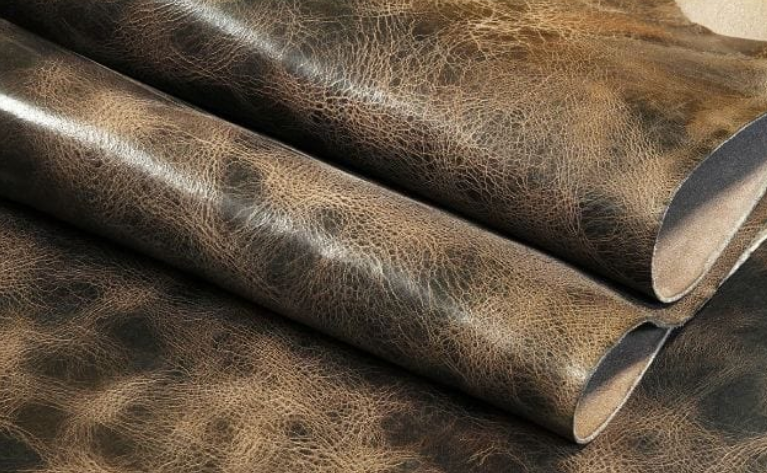
Buffalo leather is a natural leather sourced from water buffalo, renowned for its toughness, thickness, and unique grain. Compared to regular cowhide, its fiber structure is more compact, resulting in a rugged, three-dimensional grain. This not only makes it more recognizable but also gives it exceptional resistance to abrasion and tears.
1. Basic Parameters of Buffalo Leather
When crafting buffalo leather bags, the typical thickness is between 1.8mm and 2.5mm, significantly thicker than most cowhide. This ensures the finished bag maintains its stiffness and shape even after long-term use. According to leather industry testing, high-quality buffalo leather has a tensile strength of 25–30 N/mm², significantly higher than the 18–22 N/mm² of regular cowhide. It offers excellent breathability, is naturally water-resistant, and is scratch-resistant, making it a popular choice for products that must withstand weight and friction.
2. Differences Between Buffalo Leather and Cowhide
Compared with cowhide, buffalo leather has a coarser grain, firmer hand feel, and a heavier, more rugged texture. Cowhide is often smooth and supple, while buffalo leather emphasizes strength and a raw, natural aesthetic. This difference also defines their applications: cowhide is usually chosen for soft, lightweight leather goods such as garments or slim wallets, while buffalo leather is preferred for products that require durability and load-bearing capacity, such as large travel bags, work boots, or heavy-duty furniture. Many manufacturers choose buffalo leather for 40L–60L travel bags or briefcases designed to carry over 15kg, as it ensures the product maintains its structure under frequent use.
Key Differences:
● Appearance & Texture: Cowhide has a finer, smoother grain and softer touch; buffalo leather shows a bold, coarse grain with a solid, rugged feel.
● Application Scenarios: Cowhide fits better for lightweight, close-to-skin items; buffalo leather is ideal for heavy-duty goods requiring strength and long-term endurance.
3. Why Buffalo Leather is Popular in Leather Manufacturing
These characteristics make buffalo leather highly sought after in leather goods manufacturing. Data shows that India, Bangladesh, and Pakistan are the world’s major sources of buffalo hide, exporting over 800,000 tons of raw hides annually, a significant portion of which is purchased by high-end leather goods manufacturers in Europe and North America. Many buffalo leather bag makers specifically choose this leather for their high-end, durable products. It not only meets consumers’ demand for rugged practicality but also conveys a sense of natural luxury through its unique texture. For manufacturers focused on brand differentiation, buffalo leather’s uniqueness and long-lasting value make it a popular material.
“By combining precise tanning techniques, vegetable tanning processes, or advanced dyeing treatments, the unique grain and robust texture of buffalo leather can be highlighted, enhancing the individuality and luxury of each product while maintaining its natural durability, water resistance, and load-bearing strength.”
—————— Emma Liu, Senior Product Manager at Sunteam | High-End Leather Goods Manufacturing | OEM/ODM Customization | Sustainable Leather Solutions
How Buffalo Leather is Made
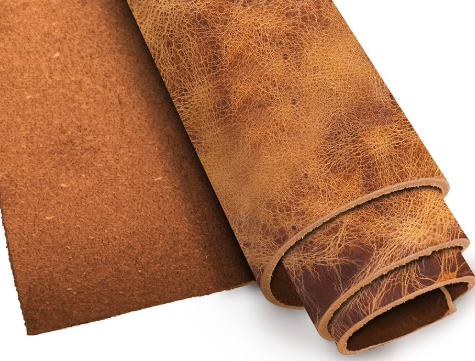
Buffalo leather is prized for its toughness and distinctive grain, and its production is a careful balance of traditional craftsmanship and modern technology. The process ensures that the leather not only retains its natural durability but also meets the aesthetic standards required for high-end leather goods. Think of it like sculpting a strong yet flexible foundation—every step shapes the character and resilience of the final product. This article will detail the Buffalo Leather Bag Manufacturing Process.
1. Raw Material Sources

Buffalo hides are primarily sourced from Asia and Africa, where water buffalo farming is common. India, Bangladesh, and Pakistan are among the leading exporters, providing thick, high-quality hides suitable for heavy-duty applications such as travel bags and work gear. The careful selection of Buffalo Leather Bag Materials ensures that only hides with minimal defects and optimal thickness are used.
Buffalo Leather Pricing per Square Foot
Buffalo leather prices vary based on quality, size, and surface treatment:
-
Per Square Foot: $7.95 – $35.00
-
Half Hide: $100.00 – $195.00
-
Full Hide: $200.00 – $449.95
2. Production Process
Raw Hide Collection
The hides are carefully collected after the animals are processed for meat, ensuring minimal damage. Only the best sections of the hide are selected for high-end leather production. This is part of the process that explains how Buffalo Leather Bags Are Made from raw hides to finished products.
Tanning Techniques (Vegetable Tanning, Chrome Tanning, etc.)
Tanning transforms raw hides into durable leather. Vegetable tanning uses natural tannins from tree bark to create a firm yet flexible leather with a rich, earthy tone, while chrome tanning speeds up the process and produces softer, more pliable leather. The precise tanning step exemplifies the Buffalo Leather Bag Craftsmanship, combining tradition with technical expertise.
Dyeing and Finishing
Buffalo leather is dyed using advanced techniques to achieve uniform color while preserving its natural grain. Finishing processes, such as polishing, embossing, or oiling, enhance water resistance and scratch durability. Detailed finishing is one of the Buffalo Leather Bag Production Steps that determines the final look and feel.
3. Differences Between Buffalo Leather and Cowhide in Production
Compared to ordinary cowhide, buffalo leather generally requires bag longer tanning times due to its thicker fiber structure. Its natural coarse grain also demands more careful finishing to avoid over-smoothing, ensuring that the characteristic texture remains visible. Properly processed buffalo leather is known for its durability, capable of withstanding years of heavy use without losing structure or beauty.
Customization and Quality
Many brands offer Custom Buffalo Leather Bags, allowing clients to choose textures, colors, and finishes tailored to their brand or personal style. Following careful selection and processing, a Buffalo Leather Bag Quality Guide is applied to inspect thickness, grain consistency, stitching, and finishing, ensuring every bag meets high-end standards.
How to Test, Certify, and Care for Buffalo Leather
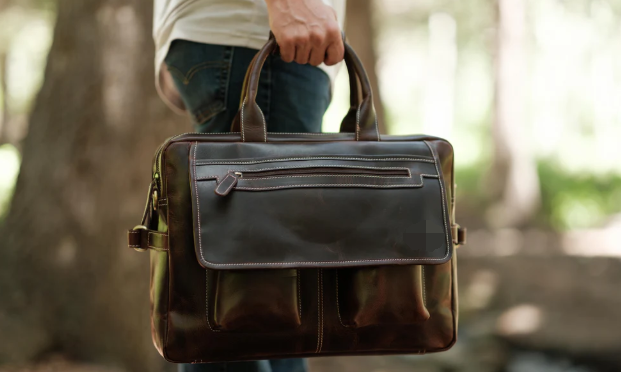
Buffalo leather is durable and resilient, but maintaining its best condition still requires proper testing, certification, and daily care. Think of it like a high-performance tool—strong yet sensitive, needing careful attention to preserve its quality.
Testing Buffalo Leather
-
Thickness and Density Test: Measure thickness and fiber density using calipers or density gauges. High-quality buffalo leather typically ranges from 1.8–2.5mm, with density higher than ordinary cowhide.
-
Tensile Strength Test: Evaluate its pulling strength, usually reaching 25–30 N/mm².
-
Flexibility and Fold Test: Repeatedly bend the leather to check for cracks or deformation. Well-tanned buffalo leather remains flexible without breaking.
-
Water Resistance Test: Droplets should bead on the surface, reflecting natural water repellency.
These steps are essential for ensuring Custom Buffalo Leather Bag Quality, particularly for high-end, personalized products.
Certification Standards
-
ISO 17065 Leather Certification: Ensures manufacturers meet international quality management standards.
-
Eco-Friendly Tanning Certification: Confirms that vegetable tanning or low-chrome processes meet environmental requirements.
-
Origin Certification: Exporting countries like India or Bangladesh provide proof of origin to guarantee legal and ethical sourcing.
Certification helps reinforce Custom Buffalo Leather Bag Durability, giving brands and consumers confidence in long-term use.
Caring for Buffalo Leather

-
Regular Cleaning: Use a soft, dry cloth to remove dust, avoiding chemical-based cleaners.
-
Leather Conditioner: Apply natural leather oil or cream every 3–6 months to maintain softness and prevent cracking.
-
Avoid Direct Sunlight and Heat: Prolonged exposure can dry out and damage the leather.
-
Proper Storage: Keep in a ventilated area, ideally in cotton or dust bags rather than sealed plastic.
-
Scratch Repair: Minor scratches can be treated with neutral leather cream; deep scratches may require professional care.
Following these tips is crucial for How to Care for Custom Buffalo Leather Bags and ensures they remain beautiful and functional for years.
Strength and Longevity
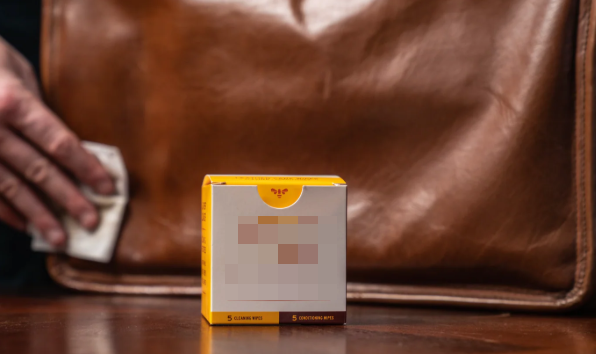
Buffalo leather’s natural toughness makes it ideal for heavy-use items, but proper care maximizes its lifespan. When maintained correctly, it offers remarkable resilience, much like a well-built foundation supporting a high-rise. Paying attention to maintenance protects the material’s structure and appearance, demonstrating the Custom Buffalo Leather Bag Strength and Longevity.
Protection Tips
To prevent accidental damage, avoid exposure to sharp objects, moisture, and extreme heat. Using protective sprays or covers can further enhance durability. These precautions are part of a comprehensive approach to Protecting Your Custom Buffalo Leather Bag, keeping it in premium condition for everyday use.
Conclusion
Buffalo leather is renowned for its rugged texture, natural durability, and timeless elegance, making it a preferred choice in the luxury leather goods industry. From sourcing high-quality hides to advanced tanning, dyeing, and finishing, the Buffalo Leather Bag Manufacturing Process ensures that each piece meets the highest standards of craftsmanship.
For businesses and individuals seeking premium products, Custom Buffalo Leather Bags offer unmatched personalization, strength, and style. By understanding how Buffalo Leather Bags Are Made and following recommended care practices, you can maximize the Custom Buffalo Leather Bag Durability, ensuring long-lasting performance and beauty.
Attention to detail in materials, stitching, and finishing is essential for any Buffalo Leather Bag Quality Guide, helping brands maintain consistency and reliability. Proper maintenance and storage, as outlined in How to Care for Custom Buffalo Leather Bags, are key to protecting your investment and Protecting Your Custom Buffalo Leather Bag against wear and tear.
Ultimately, choosing buffalo leather allows you to enjoy products with exceptional Custom Buffalo Leather Bag Strength and Longevity, combining luxury, resilience, and individuality in every item.

